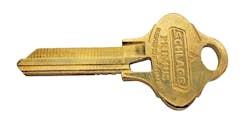Back Page, January 2023
20 Years Ago
Jerry Levine began a series that features the Hub MiniMax by IEI. Tim O’Leary reported on several access control products from Cansec Security. Stephen Steeves, ScanLock Security Technologies, discussed his line of products. Lever tumbler key fitting was the topic of an article by Gale Johnson. Tom Gillespie tested the GL650 gunlok by PRO-LOK. Jerry Levine demonstrated the procedures for servicing rekeyable padlocks made by American Lock. Levine's column included information on the Ilco Nova 2000 key duplicator, Chit key vault and lock guards by Trimco. Tim O’Leary also reported on access control systems by Intellikey. Tom Gillespie visited A-1 Corporate Hardware in Springfield, Illinois. In a woman-to-woman segment, Jennifer Robinson interviewed Dawn Schwartz and Debbie Long at their locksmith business in Oakland, California. Tiny showed how to fit keys to a Chevrolet Avalanche.
10 Years Ago
High security was our January 2013 issue cover focus. Medeco’s M3 cylinders and M3 Logic electronic cylinders were featured, along with the Schlage Everest 29 (patent-protected until 2029). Videx (now CyberLock) contributed an article on its electromechanical locking solution for a Washington theatre. Jerry Levine wrote a guide to choosing the right key machine. Gale Johnson profiled the Kaba Ilco Universal II key code machine. Joey Dalessio described how the Codelocks CL 300 Series could bring single-code keyless entry to any swinging door. Tim O’Leary reported on the introduction of high-tech residential locks, including early home-automation systems and keyless door locks. This market continues to expand. O’Leary also wrote about stand-alone locks for healthcare applications, highlighting the Essex Electronics Model SKE 34S keypad and the Securitron iMXDa delayed-egress system. Jerry Levine installed a Besam Swingmaster 900 series low-energy power operator at a medical center. Gale Johnson reported on the RCI 3590 Prox ’N Lock cabinet lock. DORMA’s (now dormakaba) purchase of RCI was announced.
Key Control and High-Security Lock Mechanisms
Note: High security has been the January cover theme for Locksmith Ledger for years, and we’ve done numerous articles on the topic. Searching the terms “high security” and “patented key systems” on our website brings up many past articles.
High security is a broad term. In our daily interaction with customers, we work with various types of security on various levels. Key control is a level of security.
Low Security – Do Not Duplicate
Many keys are marked “Do Not Duplicate” to keep them from being copied without the permission of the owner. This is the lowest level of key control.
When common everyday keys are stamped “Do Not Duplicate,” some lockshops won’t cut them without a letter of authorization. However, other outlets or kiosks ignore the stamp. You have to follow the rules of duplication that you’re comfortable with or your lockshop has agreed upon.
Medium Security – Restricted Keys
Locksmiths have some security solutions by using restricted key sections. Available only at professional locksmith security centers, these keys have unique features that eliminate the possibility of getting keys copied at another nonlocksmith location.
Cylinders or plugs are available to the locksmith that will retrofit into most popular Grade 1 and Grade 2 lock products. Restricted keys may be controlled at the locksmith dealer or at the locksmith distributor level.
Some restricted keys operate like any pin tumbler lock. The key section is unusual, but the mechanical operation is normal. Other restricted-key sections also incorporate some high-security features, such as sidebars and anti-drill blocks.
High Security – Patented Key Control
The highest level of security can be obtained by upgrading to a patented key-control system. Used in a variety of commercial and some high-end residential settings, this type of high-security lock and key can be designed to operate one door or all doors in a commercial master-key system.
Duplication of keys may be controlled by an authorized signature or the presentation of a plastic authorization card.
Accurate records are essential to maintain issuance, recovery and current status of all keys and their holders in any key-control situation.
Read full article at www.locksmithledger.com/10231070
